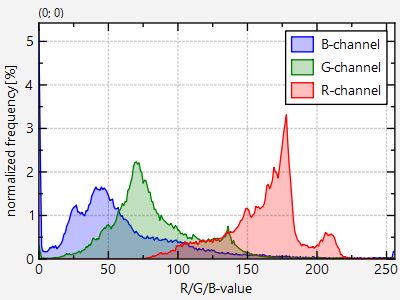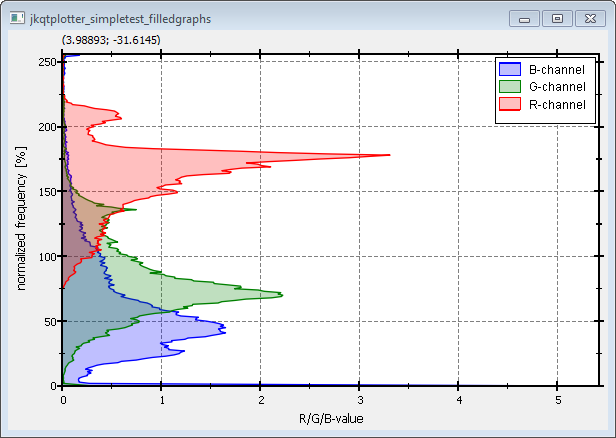mirror of
https://github.com/jkriege2/JKQtPlotter.git
synced 2024-11-15 18:15:52 +08:00
77 lines
3.0 KiB
Markdown
77 lines
3.0 KiB
Markdown
# Example (JKQTPlotter): Filled Curve Plots {#JKQTPlotterFilledGraphs}
|
|
This project (see `./examples/filledgraphs/`) simply creates a JKQTPlotter widget (as a new window) and adds several filled curve graphs (Histograms). Data is initialized from QVector<int> objects.
|
|
|
|
The source code of the main application can be found in [`filledgraphs.cpp`](https://github.com/jkriege2/JKQtPlotter/tree/master/examples/filledgraphs/filledgraphs.cpp).
|
|
|
|
First the data columns for three x-y-curves are generated. One column of x-values with entries 0,1,2,...,254,255 (256 entries).
|
|
```.cpp
|
|
size_t columnX=ds->addLinearColumn(256, 0, 255, "x");
|
|
```
|
|
|
|
And three columns with 256 entries each, which will be filled with the R-, G- and B-histograms of an image `example.bmp`:
|
|
```.cpp
|
|
size_t columnR=ds->addColumn(256, "historam_R");
|
|
size_t columnG=ds->addColumn(256, "historam_G");
|
|
size_t columnB=ds->addColumn(256, "historam_B");
|
|
```
|
|
|
|
In order to calculate the histograms, first all enries in the columns are set to 0:
|
|
|
|
```.cpp
|
|
ds->setAll(columnG, 0);
|
|
ds->setAll(columnR, 0);
|
|
ds->setAll(columnB, 0);
|
|
```
|
|
|
|
Finally the histogram is calculated:
|
|
|
|
```.cpp
|
|
QImage image(":/example.bmp");
|
|
for (int y=0; y<image.height(); y++) {
|
|
for (int x=0; x<image.width(); x++) {
|
|
QRgb pix=image.pixel(x,y);
|
|
ds->inc(columnR, qRed(pix), 1);
|
|
ds->inc(columnG, qGreen(pix), 1);
|
|
ds->inc(columnB, qBlue(pix), 1);
|
|
}
|
|
}
|
|
ds->scaleColumnValues(columnR, 100.0/static_cast<double>(image.width()*image.height()));
|
|
ds->scaleColumnValues(columnG, 100.0/static_cast<double>(image.width()*image.height()));
|
|
ds->scaleColumnValues(columnB, 100.0/static_cast<double>(image.width()*image.height()));
|
|
```
|
|
|
|
Finally three `JKQTPFilledCurveXGraph` objects are generated and added to the plot (here we show the code for the R-channel only):
|
|
|
|
```.cpp
|
|
JKQTPFilledCurveXGraph* graphR=new JKQTPFilledCurveXGraph(&plot);
|
|
|
|
// set graph titles
|
|
graphR->setTitle("R-channel");
|
|
|
|
// set graph colors (lines: non-transparent, fill: semi-transparent
|
|
QColor col;
|
|
col=QColor("red"); graphR->setColor(col);
|
|
col.setAlphaF(0.25); graphR->setFillColor(col);
|
|
|
|
// set data
|
|
graphR->setXColumn(columnX); graphR->setYColumn(columnR);
|
|
|
|
|
|
// add the graphs to the plot, so they are actually displayed
|
|
plot.addGraph(graphR);
|
|
```
|
|
|
|
The curves are fille with a semi-transparent color, which is achieved by setting `col.setAlphaF(0.25)` on the graph color `col`.
|
|
|
|
The result looks like this:
|
|
|
|

|
|
|
|
If you use `JKQTPFilledCurveYGraph` instead of `JKQTPFilledCurveXGraph`, the curve will not be filled until the y=0-axis, but until the x=0-axis. Of course you will also have to swap the x- and y-data columns. The result will look like this:
|
|
|
|

|
|
|
|
|
|
|
|
|